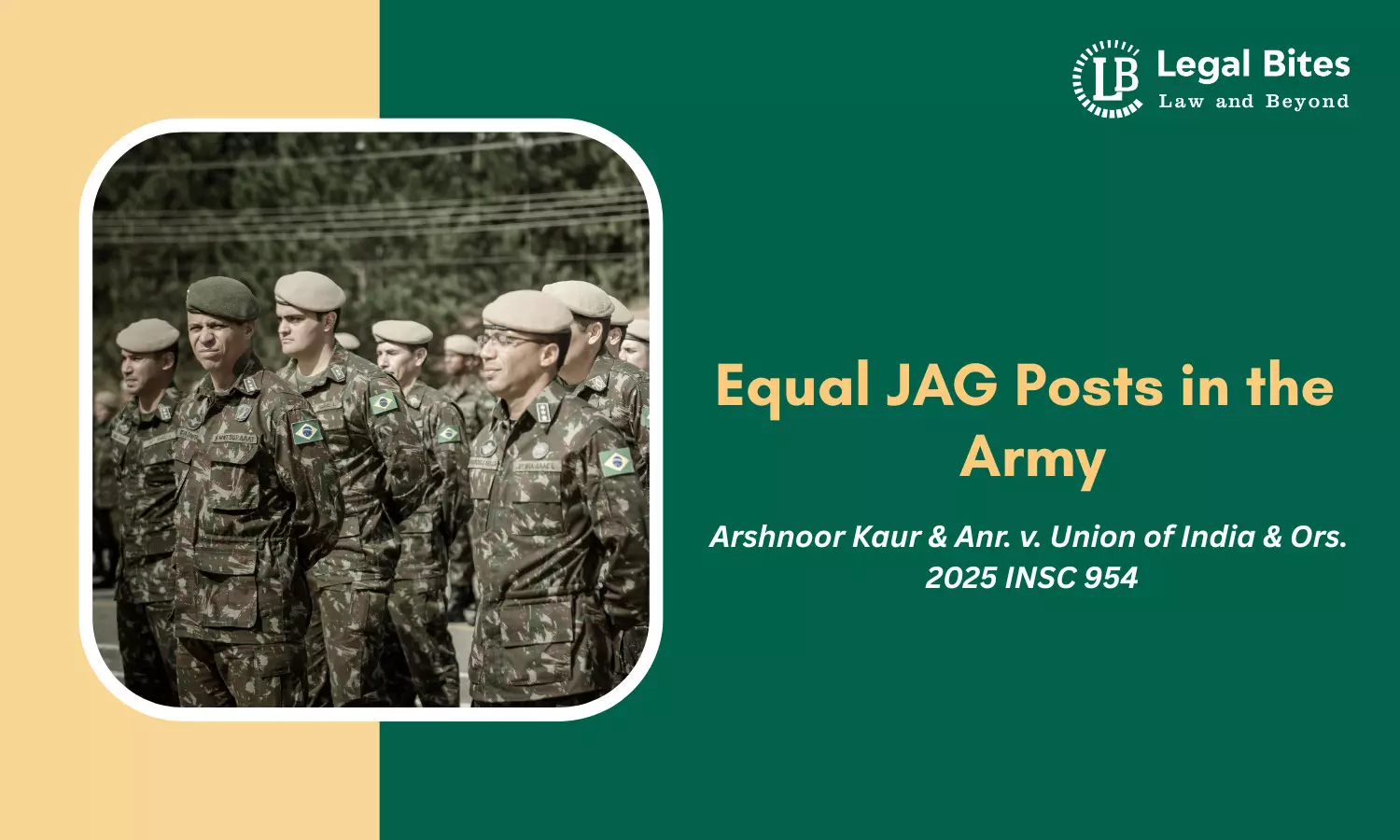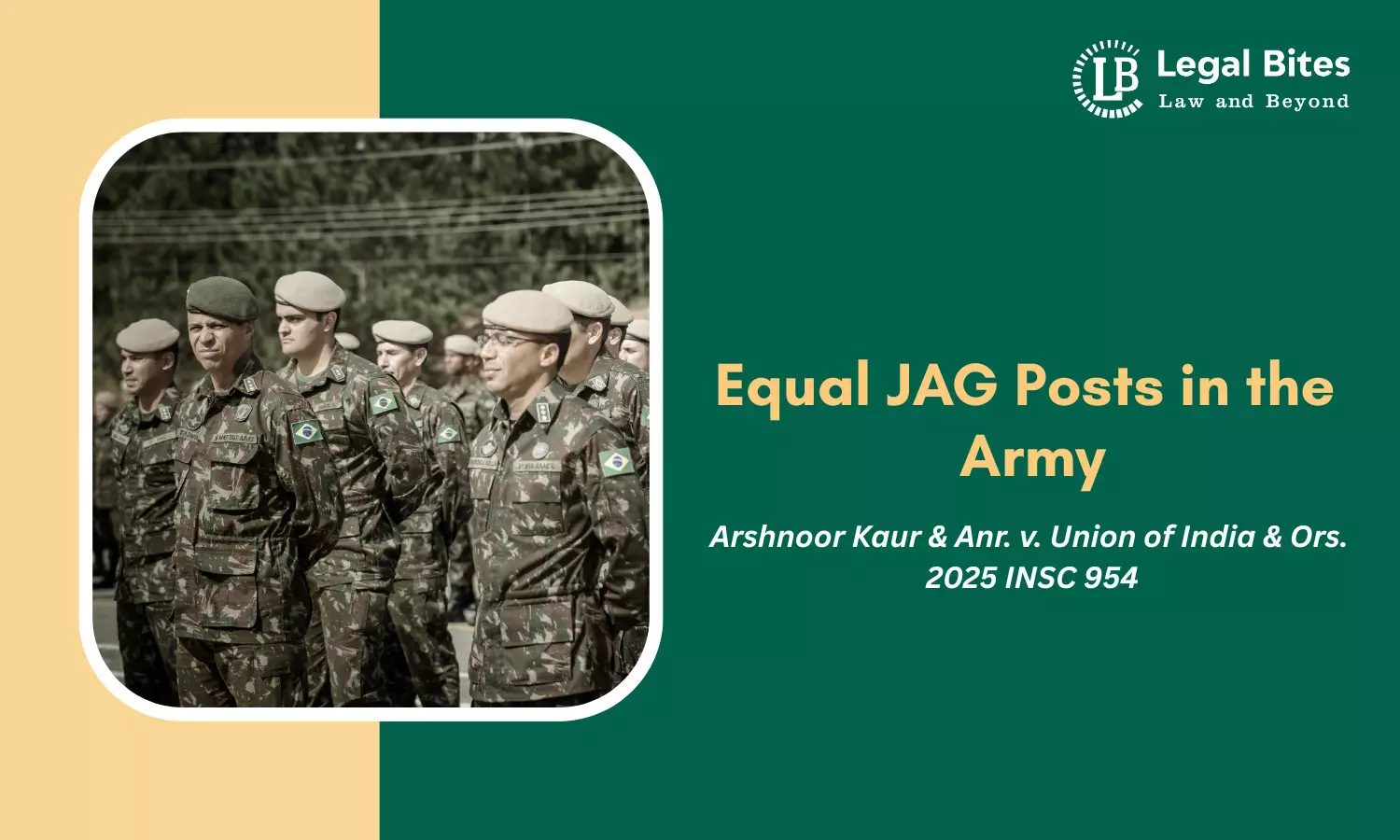Can the Army Reserve More JAG Posts for Men Than Women? Supreme Court Says No


In a landmark judgment in Arshnoor Kaur & Anr. v. Union of India & Ors. (2025 INSC 954), the Supreme Court of India has struck down the Indian Army’s policy of reserving a significantly higher number of Judge Advocate General (JAG) branch vacancies for men than for women. The verdict not only addresses the specific grievance of unequal recruitment opportunities in the armed forces but also sends a strong message that gender-based discrimination, whether in civilian or military spheres, cannot be justified under the Indian Constitution.
This article provides a comprehensive examination of the case, including the background of the dispute, the Army’s recruitment framework for the JAG branch, the arguments presented by both sides, the Court’s reasoning, and the broader implications for gender equality in the armed forces.
Background: The JAG Branch in the Indian Army
The Judge Advocate General’s Department in the Indian Army is a prestigious branch that deals with legal and judicial matters, including court-martials, service law advisory, and military justice. Both men and women are eligible to apply for short service commission (SSC) entries into the JAG branch, provided they meet the eligibility criteria relating to age, education, and fitness.
Historically, however, the Army has maintained a vacancy distribution policy that disproportionately favours men. For instance, in recent recruitment cycles, there have been announcements for around 8–10 vacancies for men compared to only 2–3 for women. The Army has justified this on the grounds of “organisational requirements” and “operational efficiency,” citing that male officers can be deployed to a wider range of roles and locations, whereas women officers are subject to certain restrictions due to policy considerations.
The Challenge Before the Supreme Court
Petitioners—comprising aspiring women candidates and serving women officers—approached the Supreme Court challenging the Army’s policy on multiple grounds:
- Violation of Article 14 (Equality Before Law) – The unequal distribution of vacancies was argued to be arbitrary, lacking any rational nexus with the stated objectives of recruitment.
- Violation of Article 15(1) (Non-discrimination on Grounds of Sex) – The policy was alleged to directly discriminate on the basis of gender without any constitutionally permissible justification.
- Contradiction to Past Supreme Court Judgments – Petitioners relied on earlier landmark rulings such as Babita Puniya v. Union of India (2020), where the Court directed the grant of Permanent Commission to women officers, stressing equality of opportunity.
- Impact on Career Progression – The skewed vacancy ratio not only affected entry opportunities but also long-term career advancement, given that initial entry numbers influence the pool for permanent commission and higher ranks.
The Army’s Defence
The Indian Army defended its policy by presenting the following arguments:
- Organisational Requirements – The Army claimed that the allocation of more posts to men was driven by operational deployment needs, especially in forward areas and challenging terrains.
- Policy-Based Restrictions on Women Officers – Certain roles in combat and high-risk zones are still closed to women officers, limiting the number of positions in which they can serve.
- No Absolute Right to Equal Vacancies – The Army argued that Article 14 does not mandate identical treatment in every scenario and that reasonable classification based on operational exigencies is permissible.
Supreme Court’s Observations
The Supreme Court rejected the Army’s justifications, making several key observations:
- Arbitrariness of Classification – The Court held that while reasonable classification is permissible, it must be based on intelligible differentia and have a rational nexus to the object sought to be achieved. The Army failed to demonstrate a clear, evidence-based rationale for drastically limiting women’s JAG vacancies.
- Changing Nature of Armed Forces Policy – The Court noted that the armed forces have progressively opened more roles to women, and using outdated restrictions as a justification for present-day inequality is untenable.
- Precedent from Babita Puniya – Recalling its earlier decision, the Court stressed that equal opportunity is a constitutional guarantee that cannot be defeated by administrative convenience.
- Article 15 and Direct Discrimination – The Court held that the vacancy ratio was a form of direct discrimination on the basis of sex, falling foul of Article 15(1).
- Constitutional Morality over Majoritarian or Institutional Preference – The Court reiterated that constitutional guarantees of equality are not subject to the will of administrative authorities, even in specialised domains like the armed forces.
The Verdict
The Supreme Court quashed the Army’s gender-discriminatory vacancy policy for the JAG branch. It directed the Army to:
- Reassess and Redesign Vacancy Allocation – The Army must determine vacancies in a gender-neutral manner, based on actual requirements and merit.
- Ensure Equal Opportunity – Future recruitment notifications must reflect equal vacancies for men and women unless a compelling, evidence-based, and constitutionally valid reason exists for deviation.
- Apply the Decision Prospectively – The Court clarified that the change would apply to upcoming recruitment cycles.
Key Highlights of Judgment
Justice Dipankar Datta and Justice Manmohan observed:
Though men and women candidates during the JAG selection procedure appear before separate boards, yet as the selection criteria and testing parameters of the fifteen (15) Officer Like Qualities are identical, this Court is of the view that combined merit list ought to be prepared.
Moreover, as held hereinabove, male and female JAG officers do not have distinct cadres with different conditions of service and the true meaning of concept of ‘gender-neutrality’ and 2023 recruitment policy is that Union of India shall recruit the most meritorious candidates in JAG branch irrespective of their sex/gender as the primary job of this branch is to give legal advice and conduct cases, but to ‘correct the past’ and to‘compensate the women for their previous non-enrolment’, the Union of India shall allocate not less than 50% of the vacancies to women candidates.
Broader Implications
- Equality Jurisprudence in the Armed Forces: This decision marks another step in the judiciary’s consistent push for dismantling gender barriers in the armed forces, complementing earlier rulings granting Permanent Commission to women in various branches of the Army and Navy.
- Recruitment and Career Progression: Equal entry opportunities will not only improve gender representation at the induction stage but also help balance promotion pipelines, ensuring that women officers have comparable opportunities for leadership roles.
- Gender-Neutral Standards: The ruling implicitly encourages the armed forces to move towards gender-neutral physical and professional standards, where eligibility is determined by ability and merit rather than gender stereotypes.
- Influence on Other Uniformed Services: The judgment could serve as a persuasive precedent for challenging similar discriminatory practices in the paramilitary forces, police services, and other uniformed sectors.
Conclusion
The Supreme Court’s quashing of the Army’s gender-skewed JAG vacancy policy is not merely a victory for the petitioners—it is a reaffirmation of the Constitution’s promise that equality is non-negotiable. The ruling emphasises that operational requirements cannot be a blanket excuse for entrenched discrimination. Instead, policy decisions must evolve with changing societal norms, technological advancements, and constitutional mandates.
By demanding equal opportunity for women in the legal arm of the Army, the Court has once again demonstrated that the armed forces, while unique in their functions, are not beyond the reach of constitutional principles. This decision strengthens the legal foundation for gender equality in one of the country’s most respected institutions and sets the tone for future reforms.
Important Link
Law Library: Notes and Study Material for LLB, LLM, Judiciary, and Entrance Exams

